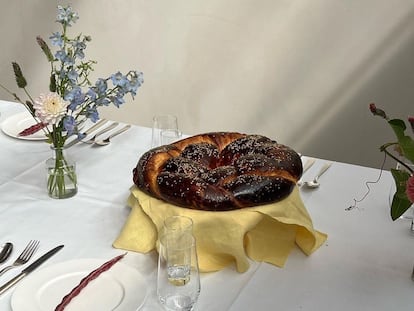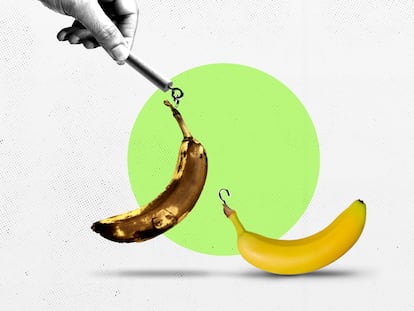The ‘Ottolenghi method’: a culinary star with a Mediterranean flavor
Cooking, laboratories, books, events... more than a great chef, he’s become a phenomenon. The culinary rock star has an empire in London that is flavored with the taste of the Middle East and North Africa
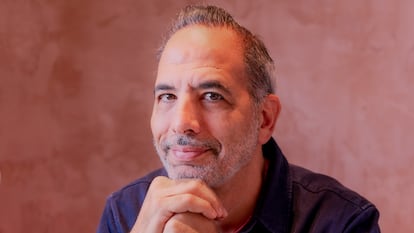
Chef Yotam Ottolenghi, 54, seems to have found a tremendously successful formula in the ultra-competitive business of gastronomy… a sector in which selling oneself — the concept, the idea, the story — is often just as important as the food itself.
Since he began his career in London more than two decades ago, he has brought the ancient Arab cuisine of the Middle East and North Africa to the trendy food scene, while also writing cooking books with his friend and partner, the Palestinian chef Sami Tamimi. Both men were born in Jerusalem. Their dynamic has continued to triumph, bringing together a joyous melting pot of chefs from countries around the world — such as Australia, Greece, Malaysia and Bahrain — under the leadership of Ottolenghi. He has become more of an orchestra director than a man who cooks.
The result is a business group that bears his name and includes nine best-selling co-authored books, four restaurants and three delis spread throughout the city of London. The company also offers catering services and its own brand of packaged products. In addition, there’s the Ottolenghi Test Kitchen (OTK), a culinary experimentation laboratory with a large presence on social media. The group’s first project outside of London will open next year in Paris (more of a deli than a restaurant).
With such an array of endeavors — something that tends to happen when a chef becomes a brand — one might wonder what really remains of Ottolenghi in this chain. EL PAÍS asked him this very question, one day at the beginning of October in his deli in the Chelsea neighborhood of London. The establishment overlooks a charming pedestrian street in one of the most exclusive areas of the British capital: it shares a block with Tiffany and Cartier.
Question. What maintains the coherence of the project? What’s the thread that continues to tie it all together?
Answer. That’s the question that keeps us up at night: what’s the Ottolenghi effect? When so many people bring their individuality to the story, what’s the common denominator? I think it’s not just one thing. There’s something very colorful about food and the way it’s presented, not just in the sense that it has a lot of color, but that there’s openness and positivity, optimism, fun, joy… nothing is too serious. I think you can have different influences and the common denominator is the fun factor, the surprise, the joy. There’s also a desire to juxtapose, to put things next to each other that may not always go together... contrasts make life more interesting. And then, there are elements that are differentiating for me, for example, the use of a lot of acidity with a little sweet flavor. Our dishes aren’t orderly: they’re like traveling along a road full of potholes, it’s not about sailing smoothly…
A perfect example of that trip is the savory cheesecake that we’re offered at NOPI. It’s one of the star dishes of the first restaurant that Ottolenghi opened in London’s Soho district 12 years ago. The cake mixes — among other ingredients — Valdeón cheese (a blue cheese produced in the Spanish province of León), thyme, honey, beets and almonds. The head chef — Dawid Nowosadzki, who hails from Poland — explains that NOPI is “a Middle Eastern restaurant with Asian elements,” in which they’ve been reducing the complexity of the dishes. This is what has happened in all parts of the group since the beginning, when jokes were made about the mountain of ingredients required for their recipes.
Nowosadzki has been working with Ottolenghi since he was 18 (he’s now 33). As a result, he’s very well aware of the “effect” that his boss was telling EL PAÍS about. He sums it up like this: “Here, you can do whatever you want. You can mix yuzu (a Japanese citrus) with olives, which is quite unusual. With French cuisine, for example, you have to follow the rules, you can’t break them, but here, as long as it works and is delicious, there are no limits.” He proudly shows off all the fresh products that are bought and consumed every day in the restaurant (he boasts of having a very small refrigerator) and talks about some of his favorite ingredients: eggplant, cauliflower and tomato.
The way of treating vegetables — turning them into protagonists of these festivals of colors and textures — has been one of Ottolenghi’s hallmarks from the beginning. In 2006, he began a collaboration with The Guardian titled The New Vegetarian, which was a big leap on the path to fame for this chef, who studied Comparative Literature in university.
He later worked for a couple of media outlets before arriving in London in the late-1990s, with the goal of becoming a chef. He studied French cuisine at Le Cordon Bleu and worked as a pastry chef in several fine dining restaurants until, in 2002, he opened his first deli in Notting Hill. Then came the books, the television shows, the expansion, the success... according to the latest public tax filings, the group has recorded profits of more than $7 million.
Q. Have you ever felt like you have too many things on your plate? Do you get overwhelmed?
A. Yes, often. Although, I think we’ve been modest in terms of expansion and growth. It’s true that I can’t stop thinking about how to maintain quality, because food is something that has to be cooked every day — it’s not like a [regular] product where you do a formula and it always comes out the same. We establish processes to control it, but still, something can always go wrong. That keeps me up at night.
Q. With so many places to look after, what’s a typical day like for you?
A. On most days, I go to my test kitchen (OTK), which is a kind of company headquarters. I spend a lot of my time there, discussing all the things we’re developing. Everything revolves around ideas about food or service. Years ago, we decided to create a space where many people could try out [new recipes] and have those conversations. That’s become our way of creating new recipes. They’re never the result of a single person doing something, but rather, they’re the result of a conversation. And I sincerely believe that this is the reason for the success of our books. If I worked alone, I would have run out of ideas a long time ago.
That space is, in fact, the protagonist of two of the latest titles by Ottolenghi and Sami Tamimi: Extra Good Things (2022) and Shelf Love (2021). The third author is Noor Murad, who was born in Bahrain and trained in New York City. She’s in charge of the test kitchen. In fact, she conceived of the idea of publishing the books during the COVID-19 pandemic, as a tool to “empty pantry shelves, cabinets, refrigerators and freezers” and put the leftover ingredients together using recipes with the Ottolenghi touch. Here are three hand-picked examples: salty oatmeal porridge with bits of garlic and ginger, tabbouleh fritters with spicy sauce… and chocolate flan.
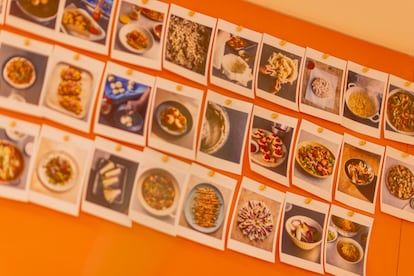
The OTK is the center of gravity, but Ottolenghi also insists on giving the well-deserved credit to the chefs in the restaurants and delis, which he visits whenever he can. He reviews the presentations, rearranges products on the display shelves, poses for photographs behind the window of his Chelsea shop, tastes the dishes, makes corrections…
“Maybe he’s not involved in the day-to-day,” Nowosadzki admits. “But when he comes in, he gives the place his special touch.”
A touch that no one explained out loud to Nowosadzki when he arrived. The new hires aren’t taught about it either — they learn as they go. Christos Karetsos — of Greek origin, the head chef at Ottolenghi Spitalfields — didn’t receive any talk when he began working at NOPI six years ago. Since then, he explains that he’s learned, for example, to value vegetables — “personally, I prefer meat, but some vegetables can be tastier than meat” — and to create dishes within a space filled with continuous conversations between different people. Of course, there are some limits… in this case, the ones physically marked on a map hanging in the kitchen, which delimits the culinary traditions of the Middle East and North Africa.
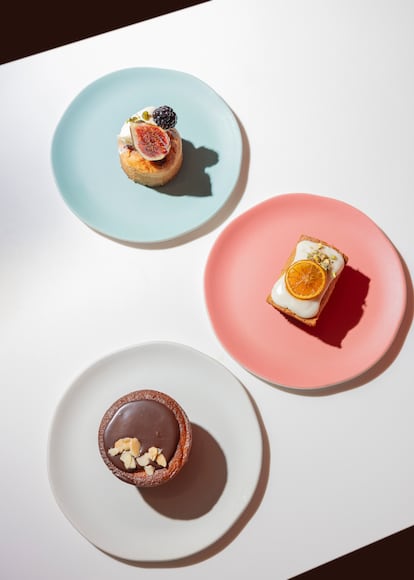
At the entrance of the test kitchen, there’s a beautiful landscape of cakes and pastries, which stands out in the space. Undoubtedly, this capacity for esthetics is another of Ottolenghi’s strong points. Precisely for this reason, in 2018, the Metropolitan Museum of Art in New York commissioned him to organize a gastronomic gala that he turned into a great culinary and cultural event. This was reflected in the documentary Ottolenghi and the Cakes of Versailles. Before this production, he had already starred in another: Jerusalem on a Plate. In Australia, he’s particularly well-known, having participated as a guest judge in several editions of MasterChef. In Holland and Belgium, his events are typically attended by more than 1,000 people.
Q. Have you ever felt like a rock star?
A. Once in a while. And it’s strange, because I don’t feel like I’ve earned it.
Q. What do you think about the phenomenon of the star chef?
A. It’s part of a broader phenomenon: many people become famous for all kinds of reasons. I don’t think anything I do justifies my position as a cultural phenomenon. It seems pretty random to me who gets the world’s attention and who doesn’t. I’m a little skeptical.
Q. Do you think that this phenomenon has changed gastronomy? Has it changed what it means to be a chef today?
A. Yeah. When I started working in a kitchen, about 25 years ago, the only thing I thought about was the food, the customer experience, the look of the dish, the menu, what people like to eat and what they don’t... and now I think we spend most of our time thinking about other things. What does what we do mean? What kind of impact do we have on the environment, on society?
Q. And is that bad?
A. We’ve gone too far in that other direction. Many people tell me their ideas for restaurants and it takes them half-an-hour to talk about the food. They start with whether it’s going to be sustainable, whether it’s going to be farm-to-table... and those things are really important, but sometimes, [the future restaurateurs] don’t even know what kind of food they’re going to serve. That’s putting the cart before the horse. Food has to do with sensuality, with the experience of putting something in your mouth and feeling that ecstasy. I don’t think it’s wise to think about other things before that.
Sign up for our weekly newsletter to get more English-language news coverage from EL PAÍS USA Edition
Tu suscripción se está usando en otro dispositivo
¿Quieres añadir otro usuario a tu suscripción?
Si continúas leyendo en este dispositivo, no se podrá leer en el otro.
FlechaTu suscripción se está usando en otro dispositivo y solo puedes acceder a EL PAÍS desde un dispositivo a la vez.
Si quieres compartir tu cuenta, cambia tu suscripción a la modalidad Premium, así podrás añadir otro usuario. Cada uno accederá con su propia cuenta de email, lo que os permitirá personalizar vuestra experiencia en EL PAÍS.
¿Tienes una suscripción de empresa? Accede aquí para contratar más cuentas.
En el caso de no saber quién está usando tu cuenta, te recomendamos cambiar tu contraseña aquí.
Si decides continuar compartiendo tu cuenta, este mensaje se mostrará en tu dispositivo y en el de la otra persona que está usando tu cuenta de forma indefinida, afectando a tu experiencia de lectura. Puedes consultar aquí los términos y condiciones de la suscripción digital.
More information
Últimas noticias
Alain Aspect, Nobel laureate in physics: ‘Einstein was so smart that he would have had to recognize quantum entanglement’
Imelda Castro, the woman who wants to rule the cartel battleground of Sinaloa
The new victims of the Republican war on Obamacare: Millions hit by soaring health insurance premiums
A country divided on migrant rights: Some US states expand protections while others restrict them
Most viewed
- David King, chemist: ‘There are scientists studying how to cool the planet; nobody should stop these experiments from happening’
- Reinhard Genzel, Nobel laureate in physics: ‘One-minute videos will never give you the truth’
- Oona Chaplin: ‘I told James Cameron that I was living in a treehouse and starting a permaculture project with a friend’
- Sinaloa Cartel war is taking its toll on Los Chapitos
- Mexico completes its trade shift with the entry into force of tariffs on China and countries without trade agreements

